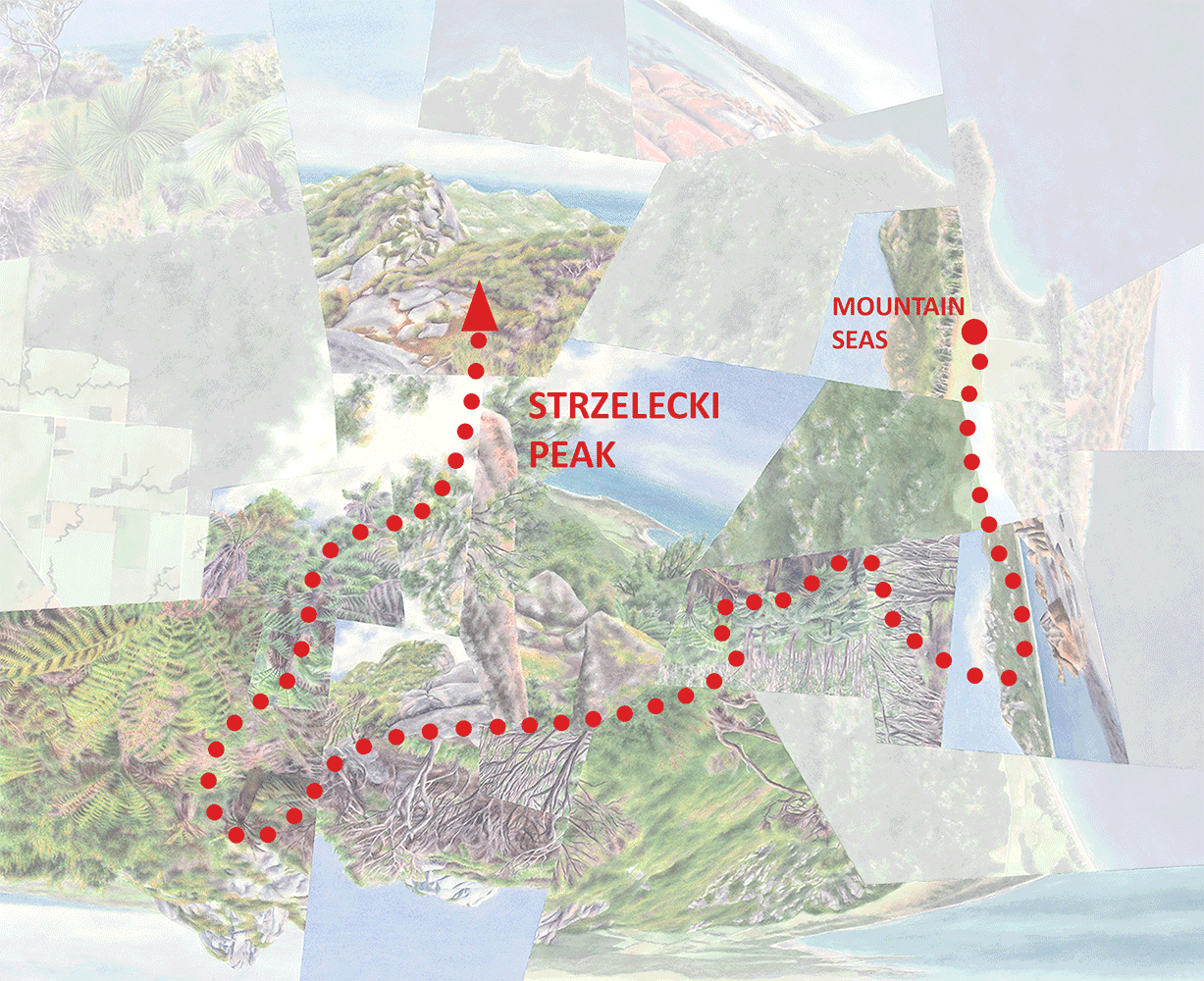To finish up this “Urban Wilds” series as I began it (with a concrete example, in that case Rio de Janeiro), I’ll dive into a recent work, Peaks, inspired by my current home city of San Francisco.
Peaks, watercolor on paper, 42”x37.” The north peak—near the center of the composition, with the upside-down steps—is meant to be the focal point.
This worldview focuses on Twin Peaks—at around 900’ San Francisco’s second-highest point, consisting of two peaks (north and south) that give the place its name. The site is one of the city’s few open spaces that still retains the structure and character of the area’s original landscape—mostly grassland and shrubland particularly in exposed, elevated areas. Most of the city’s other parks have been forested or otherwise completely transformed. Species-wise Twin Peaks has been largely taken over by invasives, but that isn’t obvious to the untrained eye, and restoration efforts are ongoing.
The site’s elevation and its location near the city’s geographical center have made it an iconic landmark and a popular destination. As I’ve suggested in an earlier post its windswept, treeless landscape (in addition to affording 360-degree views) probably has some role in preserving a semblance of coastal California identity that has been otherwise obscured by artificial forests. But I think it has an even greater prominence in my personal experience of the city. First, I live close to the base of the slope—it takes less than 40 minutes to walk to the tops of the peaks. And second, as you’d expect, I gravitate toward it as a relict of a native local ecosystem.
The streets of San Francisco, with Twin Peaks in the distance.
The site’s prominence is one reason why in Peaks I’ve given it a particularly outsized place in the composition. But that emphasis, as well as my decision to feature it in the first place, of course also has a lot to do with my interest in the dramatic urban-wild contrast. Throughout this “Urban Wilds” series I haven’t said much about what type of landscape the “wild” part refers to except that for me it means an environment in a relatively natural state—not unimpacted by human activity (because there’s no longer such a place) but maintaining enough of the structure and composition of the original ecosystem for it to feel that way. To achieve what I’ve written about as the psychological and cultural benefits of bringing some amount of nature into the city, it doesn’t really matter what that ecosystem is. But to satisfy my own idiosyncratic fascination with the urban-wild contrast, which I explore in many of the worldviews, it does make a difference.
View of the park from the streets climbing the lower slopes.
The more unexpected the juxtaposition—the more “wild” the natural half—the more inspiring it is for me. My “Urban Volcanoes” series delves into my favorite example, which I experience as tamed geological power. Another example, ecological in this case, is the saturated, windswept páramo of Andes, juxtaposed with village and agriculture. As ecological examples go, for reasons that are hard to articulate, it’s these high, exposed, damp, and misty places that I find so entrancing when juxtaposed with civilization. (More so than, say, deserts, which are at least as inhospitable. It might be that páramo and other similar environments tend to be topographically isolated and inaccessible, and so I find it particularly exciting when they instead appear right at your doorstep.) But why am I talking about this in reference to a hilltop in the middle of San Francisco, treeless but not particularly high, cold, or wet? I think the answer is that the city’s famous foggy, blustery weather—not as perpetual as many people think, but definitely pronounced in elevated and exposed places—has inspired me to imagine Twin Peaks as more forbidding, exotic, and atmospheric than its physical reality would suggest. That imagined version seems to persist in my mind even when it’s sunny, and so I didn’t feel the need to alter the weather in the worldview (though someday I might create a foggy version).
A tiny glimpse of the park between buildings a few streets away.
Reaching the urban-wild edge.
The urban-wild contrast at Twin Peaks is sharp in the sense that generally the urban fabric does suddenly give way to the barren slopes. Even though much of the adjacent development is made up of detached houses, the edge is compressed enough that there’s no petering out into rustic buildings and dirt roads. And, some parts of the boundary are hardened by medium-rise apartment blocks. But on the other hand the shape of the edge is convoluted, with fingers of park and city intermingling, and the two landscapes aren’t topographically distinct—city streets climb far up the base of the landform. Also, though from adjacent streets the peaks do tend to suddenly reveal themselves between buildings or when rounding a corner, from farther away they’re more a fixture of the landscape. So the urban-wild edge here is complex: it separates two distinct environments, but at the same time it represents an interplay between the two that changes as you approach the edge and then cross it. It’s this complexity that I’ve aimed to capture in Peaks, as well as in other works inspired by similar contrasts.
Darren
City vista from below the north peak.
View of the south peak from the summit of the north peak.























